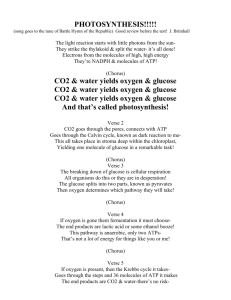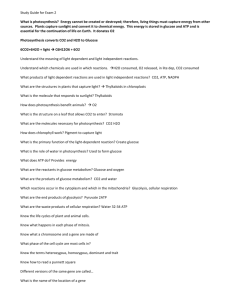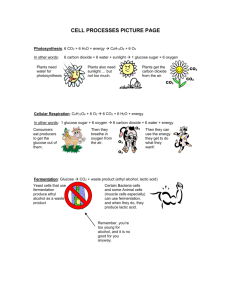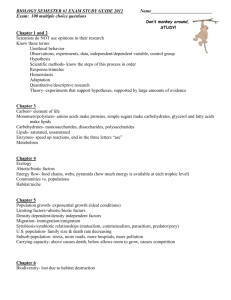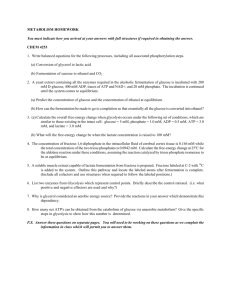Glycolysis & Fermentation
advertisement
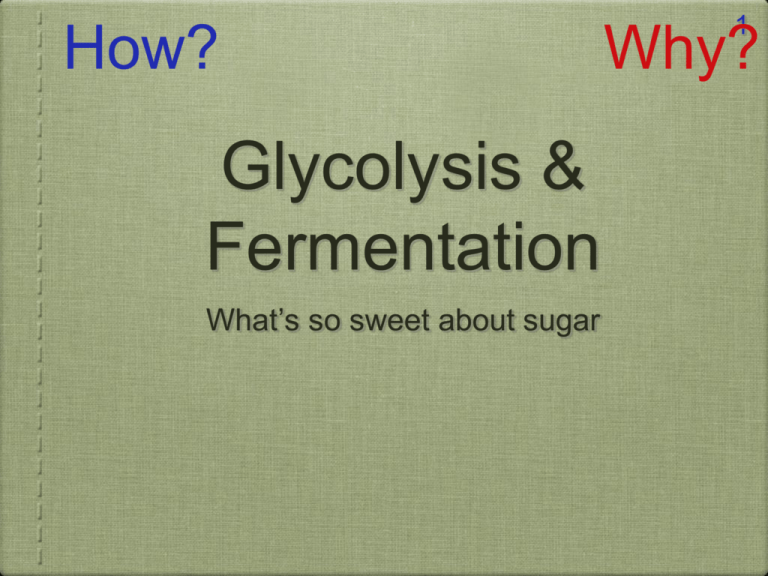
How? Glycolysis & Fermentation What’s so sweet about sugar 1 Why? 2 3 Think it through • CH4 H3C-CH2-OH (ethanol) CH3(CH2)6CH3 (octane) • H2O CO2 • What’s the difference in behavior? (please phrase your answer in the form of a question) • in structure? Where the cals are Where is the energy in a molecule of glucose? http://www.biotopics.co.uk/as/glucose2.html Also available (alt. ring form) in the StructViewer ‘Small’ submenu http://youtube.com/watch?v=CJ-pSfXcXtw&feature=related 4 What’s so great about ATP Biology, Freeman, Fig. 9.1A 5 6 7 Gettin’ all experimental on you A claim glucose + 2ADP + 2Pi + 2NAD+ => 2 pyruvic acid + 2NADH+ + ATP pyruvic acid + NADH+ => ethanol + CO2 + 2NAD+ • How much can you test? • What conditions are needed? • What steps should you take/samples should you prepare? consider: yeast prefers glucose + O2 + ADP + Pi => CO2 + H20 + ATP 8 Brainstorming phase glucose + 2ADP + 2Pi + 2NAD+ => 2 pyruvic acid + 2NADH+ + ATP pyruvic acid + NADH+ => ethanol + CO2 + 2NAD+ • How many tests can you & your peeps come up with? • Rank them in terms of • feasibility • safety 9 10 Group discussion • What have you come up with? • On what basis will you be drawing conclusions at the end of the experiment • • making comparisons between the final result and...? Should everyone do an identical experiment? Why or why not? A ‘standard’ protocol • Standard meaning there is more to it than that, take notes! • manual p. 10-7 11 Optimizations • We’ve proposed testing for several components • Are all tests best performed under the same conditions? • Concept: limiting component. How do we maximize our sensitivity/yield for • Glucose? • CO2? • Ethanol? 12 How much to use • Optimizing for glucose – less glucose • • 13 Manual says to use 1x glucose so half of this would be 0.5X, how will you achieve this? Optimizing for ethanol/CO2 • Use 2X glucose Glucose Test 14 • When should samples be taken? • Control? • Start all test tubes for glucose at same or different times? • Where should you keep the before sample or glucose so it does not react? • How would you propose to get rid of gunk from yeast? CO2 Test • How will we tell if CO2 is present? Ethanol Test • How will we get the ethanol out? • At what point does water boil? Do we want to get to that point? • What might make this process work better? • When we do, how will we test its presence? 15 After mixing... • On the fasterness of warmness 16 What’ll that prove? • A key aspect of this lab, as will be highlighted by the Assessor HW, is distinguishing degrees of certainty in the findings 17 18 AFTER no heating parafilm!!! Thermometer should measure GAS temp, leave it up high! Reports • You will write a report as a group for the findings of the lab • Be sure to indicate which optimization you used, how much glucose? What were you optimizing for and why? • The report is bulleted but must be complete 19 Points about reports 20 • Introduction – background on the process of glycolysis and fermentation. Hypothesis about outcome is important, make sure it is clear. What do you expect will happen? • No materials list needed, that is in the lab manual and I will get a sense of what you used by your description of the methods • Methods should indicate how each test was set up and what each test will prove (remember to base off your optimization method) • Results are strictly reporting what happened (what did you see), not why or how • Discussion – analyze results, why did the results turn out the way they did, was it what you expected to see and why or why not? 21 Homework

